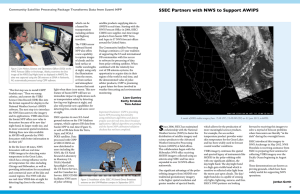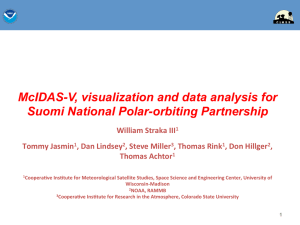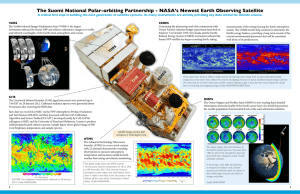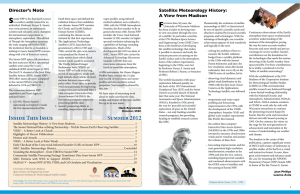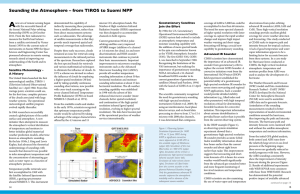Community Satellite Processing Package Transforms Data from Suomi NPP
advertisement
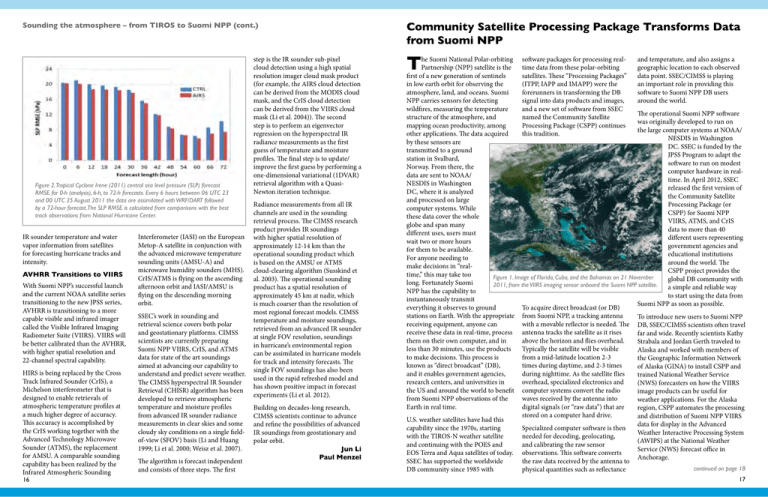
Sounding the atmosphere – from TIROS to Suomi NPP (cont.) Figure 2.Tropical Cyclone Irene (2011) central sea level pressure (SLP) forecast RMSE for 0-h (analysis), 6-h, to 72-h forecasts. Every 6 hours between 06 UTC 23 and 00 UTC 25 August 2011 the data are assimilated with WRF/DART followed by a 72-hour forecast.The SLP RMSE is calculated from comparisons with the best track observations from National Hurricane Center. IR sounder temperature and water vapor information from satellites for forecasting hurricane tracks and intensity. AVHRR Transitions to VIIRS With Suomi NPP’s successful launch and the current NOAA satellite series transitioning to the new JPSS series, AVHRR is transitioning to a more capable visible and infrared imager called the Visible Infrared Imaging Radiometer Suite (VIIRS). VIIRS will be better calibrated than the AVHRR, with higher spatial resolution and 22-channel spectral capability. HIRS is being replaced by the Cross Track Infrared Sounder (CrIS), a Michelson interferometer that is designed to enable retrievals of atmospheric temperature profiles at a much higher degree of accuracy. This accuracy is accomplished by the CrIS working together with the Advanced Technology Microwave Sounder (ATMS), the replacement for AMSU. A comparable sounding capability has been realized by the Infrared Atmospheric Sounding 16 Interferometer (IASI) on the European Metop-A satellite in conjunction with the advanced microwave temperature sounding units (AMSU-A) and microwave humidity sounders (MHS). CrIS/ATMS is flying on the ascending afternoon orbit and IASI/AMSU is flying on the descending morning orbit. SSEC’s work in sounding and retrieval science covers both polar and geostationary platforms. CIMSS scientists are currently preparing Suomi NPP VIIRS, CrIS, and ATMS data for state of the art soundings aimed at advancing our capability to understand and predict severe weather. The CIMSS hyperspectral IR Sounder Retrieval (CHISR) algorithm has been developed to retrieve atmospheric temperature and moisture profiles from advanced IR sounder radiance measurements in clear skies and some cloudy sky conditions on a single fieldof-view (SFOV) basis (Li and Huang 1999; Li et al. 2000; Weisz et al. 2007). The algorithm is forecast independent and consists of three steps. The first step is the IR sounder sub-pixel cloud detection using a high spatial resolution imager cloud mask product (for example, the AIRS cloud detection can be derived from the MODIS cloud mask, and the CrIS cloud detection can be derived from the VIIRS cloud mask (Li et al. 2004)). The second step is to perform an eigenvector regression on the hyperspectral IR radiance measurements as the first guess of temperature and moisture profiles. The final step is to update/ improve the first guess by performing a one-dimensional variational (1DVAR) retrieval algorithm with a QuasiNewton iteration technique. Radiance measurements from all IR channels are used in the sounding retrieval process. The CIMSS research product provides IR soundings with higher spatial resolution of approximately 12-14 km than the operational sounding product which is based on the AMSU or ATMS cloud-clearing algorithm (Susskind et al. 2003). The operational sounding product has a spatial resolution of approximately 45 km at nadir, which is much coarser than the resolution of most regional forecast models. CIMSS temperature and moisture soundings, retrieved from an advanced IR sounder at single FOV resolution, soundings in hurricane’s environmental region can be assimilated in hurricane models for track and intensity forecasts. The single FOV soundings has also been used in the rapid refreshed model and has shown positive impact in forecast experiments (Li et al. 2012). Building on decades-long research, CIMSS scientists continue to advance and refine the possibilities of advanced IR soundings from geostationary and polar orbit. Jun Li Paul Menzel Community Satellite Processing Package Transforms Data from Suomi NPP T he Suomi National Polar-orbiting software packages for processing realand temperature, and also assigns a Partnership (NPP) satellite is the time data from these polar-orbiting geographic location to each observed first of a new generation of sentinels satellites. These “Processing Packages” data point. SSEC/CIMSS is playing in low earth orbit for observing the (ITPP, IAPP and IMAPP) were the an important role in providing this atmosphere, land, and oceans. Suomi forerunners in transforming the DB software to Suomi NPP DB users NPP carries sensors for detecting signal into data products and images, around the world. wildfires, measuring the temperature and a new set of software from SSEC The operational Suomi NPP software structure of the atmosphere, and named the Community Satellite was originally developed to run on mapping ocean productivity, among Processing Package (CSPP) continues the large computer systems at NOAA/ other applications. The data acquired this tradition. NESDIS in Washington by these sensors are DC. SSEC is funded by the transmitted to a ground JPSS Program to adapt the station in Svalbard, software to run on modest Norway. From there, the computer hardware in realdata are sent to NOAA/ time. In April 2012, SSEC NESDIS in Washington released the first version of DC, where it is analyzed the Community Satellite and processed on large Processing Package (or computer systems. While CSPP) for Suomi NPP these data cover the whole VIIRS, ATMS, and CrIS globe and span many data to more than 40 different uses, users must different users representing wait two or more hours government agencies and for them to be available. educational institutions For anyone needing to around the world. The make decisions in “realCSPP project provides the time,” this may take too Figure 1. Image of Florida, Cuba, and the Bahamas on 21 November global DB community with long. Fortunately Suomi 2011, from the VIIRS imaging sensor onboard the Suomi NPP satellite. a simple and reliable way NPP has the capability to to start using the data from instantaneously transmit Suomi NPP as soon as possible. everything it observes to ground To acquire direct broadcast (or DB) stations on Earth. With the appropriate from Suomi NPP, a tracking antenna To introduce new users to Suomi NPP receiving equipment, anyone can with a movable reflector is needed. The DB, SSEC/CIMSS scientists often travel receive these data in real-time, process antenna tracks the satellite as it rises far and wide. Recently scientists Kathy them on their own computer, and in above the horizon and flies overhead. Strabala and Jordan Gerth traveled to less than 30 minutes, use the products Typically the satellite will be visible Alaska and worked with members of to make decisions. This process is from a mid-latitude location 2-3 the Geographic Information Network known as “direct broadcast” (DB), times during daytime, and 2-3 times of Alaska (GINA) to install CSPP and and it enables government agencies, during nighttime. As the satellite flies trained National Weather Service research centers, and universities in overhead, specialized electronics and (NWS) forecasters on how the VIIRS the US and around the world to benefit computer systems convert the radio image products can be useful for from Suomi NPP observations of the waves received by the antenna into weather applications. For the Alaska Earth in real time. digital signals (or “raw data”) that are region, CSPP automates the processing stored on a computer hard drive. and distribution of Suomi NPP VIIRS U.S. weather satellites have had this data for display in the Advanced capability since the 1970s, starting Specialized computer software is then Weather Interactive Processing System with the TIROS-N weather satellite needed for decoding, geolocating, (AWIPS) at the National Weather and continuing with the POES and and calibrating the raw sensor Service (NWS) forecast office in EOS Terra and Aqua satellites of today. observations. This software converts Anchorage. SSEC has supported the worldwide the raw data received by the antenna to continued on page 18 DB community since 1985 with physical quantities such as reflectance 17 Community Satellite Processing Package Transforms Data from Suomi NPP which can be a hazard for transportation including airlines and highway travellers. The VIIRS sensor onboard Suomi NPP also offers a new capability to capture images of clouds and the land surface at visible wavelengths Figure 2. Jim Nelson, Science and Operations Officer (SOO) at the at night, using only NWS Forecast Office in Anchorage, Alaska, examines the first the illumination image of the VIIRS Day/Night band as displayed in AWIPS.The from the moon, data was captured using the DB antenna at GINA in Fairbanks, or from surface AK, automatically processed using CSPP software. and atmosphere features that emit light when there is no moon. This new “The first step was to install CSPP,” feature of Suomi NPP will have an Strabala says. “Then we remap, immediate impact in applications such colorize, and convert the VIIRS as transportation safety by detecting Science Data Record (SDR) files into low fog over highways at night, and the format required for display in the also will provide new capabilities for National Weather Service’s AWIPS detecting fires, smoke and snow cover software. The next step is to introduce at night. the NWS forecasters to the imagery and its applications. VIIRS data from SSEC operates its own X/L-band the Suomi NPP offers new value to ground station on the UW-Madison forecasters because of its new day/ campus, which captures DB data from night band, its larger swath size, and Suomi NPP in real-time (Figure 3), its more consistent spatial resolution. as well as DB data from the Terra, Making these new data available Aqua, and NOAA in AWIPS will provide the NWS POES satellites. Data forecasters with better information to processed with CSPP do their job.” at SSEC/CIMSS are In the the lower 48 states, NWS forecasters will use real-time VIIRS imagery for detecting water temperature in the Great Lakes, which has a strong influence on the air temperature for cities including Chicago and Milwaukee, as well as providing information for recreational and commercial users of the lake and coastal regions. The NWS will also use real-time VIIRS data at night for detecting fog close to the surface, 18 now distributed to users including the NWS, the US Naval Research Laboratory in Monterey CA, NASA Marshall Spaceflight Center, the US Forest Service, and the Canadian Ice Service. SSEC/CIMSS facilitates NWS users of polar-orbiting SSEC Partners with NWS to Support AWIPS satellite products supplying data to AWIPS in real-time. Starting with the NWS Forecast Office in 2006, SSEC/ CIMSS now supplies real-time image products from Suomi NPP, Terra, and Aqua to 57 NWS forecast offices around the United States. The Community Satellite Processing Package continues a 25-year tradition of supporting the US and international DB communities with free access to software for processing of data from polar-orbiting satellites. When combined with the relatively low cost of DB antenna systems, the opportunity to acquire data in their region of the world in real time, and the demonstrated value of polarorbiter products, CSPP is promising a great future for those involved in weather forecasting and environmental monitoring. Liam Gumley Kathy Strabala Tom Achtor Important Disclaimer: CSPP is providing Suomi NPP processing functionality using preliminary algorithms and data to prepare users for real-time direct broadcast applications. Official algorithms are pending and the Suomi NPP calibration/validation checkout has not been completed. Figure 3. Installation of the SSEC X/L-band Direct Broadcast antenna on the UW-Madison campus in September 2011. A swath of VIIRS visible imagery from 17:49 UTC (12:49 PM CDT) on 22 June 2012, in AWIPS. S ince 2006, SSEC has maintained a relationship with the National Weather Service (NWS) to foster the distribution of satellite imagery and science products to the Advanced Weather Interactive Processing System (AWIPS) at field offices. This collaboration began with the Milwaukee NWS office receiving MODIS imagery collected using an antenna atop SSEC and has since expanded to over 50 NWS offices nationwide. One significant advantage of the polarorbiting imagery from MODIS over traditional geostationary imagery is the higher spatial resolution and greater number of spectral bands, which allows for the production of more meaningful science products. For example, the sea surface temperature product provides water skin temperature for the Great Lakes and has been widely used to forecast coastal weather conditions. VIIRS imagery continues the spatial and spectral legacy of instruments like MODIS in the polar-orbiting orbit with one significant addition, the day/night band. The day/night band is a high-gain visible band which is sensitive to reflected solar light from the moon cast upon clouds. The day/ night band also is capable of sensing city lights, lightning, auroras, and fires. SSEC’s NWS partners are looking forward to receiving this imagery to solve a myriad of forecast problems where forecasters are literally “in the dark” during the overnight hours. SSEC introduced this imagery to NWS Anchorage in May 2012. NWS Honolulu is receiving assistance from SSEC in preparing their antenna for collecting VIIRS imagery over the Pacific Ocean beginning in August 2012. These demonstrations are known as proving grounds, which have been widely useful for supporting NWS operations. Jordan Gerth 19
